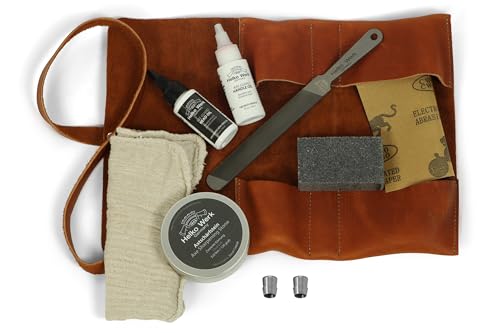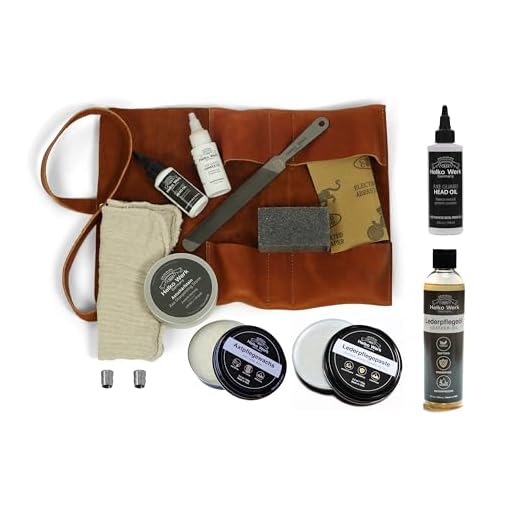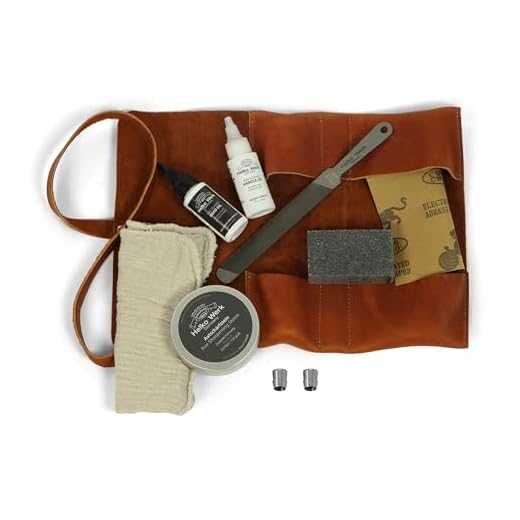




Having a sharp axe is essential for effective chopping and splitting wood. Over time, the edge of your axe can become dull and less efficient. Luckily, with the help of a sharpening stone, you can easily restore your axe’s sharpness and get back to tackling your wood-cutting tasks with ease.
A sharpening stone, also known as a whetstone, is a tool specifically designed to sharpen blades. It consists of a flat surface made of abrasive material, such as natural or synthetic stone. By rubbing the blade of your axe against the sharpening stone, you can remove any burrs or nicks and create a razor-sharp edge.
Before you begin the sharpening process, it’s important to take some safety precautions. Make sure you have a stable work surface and secure the axe in place using a vice or clamp. Wear protective gloves and safety glasses to protect your hands and eyes from any flying debris. Additionally, ensure that the area is well-ventilated to avoid inhaling any dust particles generated during sharpening.
To start sharpening your axe, position the sharpening stone on a flat surface. Hold the axe firmly with both hands, placing the blade’s cutting edge against the stone at a 20-degree angle. Apply light pressure and move the axe back and forth in smooth, even strokes, maintaining the same angle throughout the process. Repeat this motion for several minutes, gradually working your way from the base of the blade to the tip.
After each stroke, check for any visible improvements in the blade’s sharpness. If necessary, add a small amount of water or honing oil to the stone to lubricate the surface and enhance the sharpening process. Continue sharpening until the entire cutting edge is uniformly sharp and free from nicks or dull spots.
Once you are satisfied with the sharpness of your axe, rinse off any debris from the blade and dry it thoroughly. You can use a soft cloth or towel to remove any excess moisture. Finally, apply a thin layer of oil to the blade to help prevent rust and keep it in optimal condition.
By following these steps and regularly maintaining your axe’s sharpness, you can enjoy smooth, efficient wood chopping and ensure the longevity of your axe for years to come.
Choosing the Right Sharpening Stone
When it comes to sharpening your axe, using the right sharpening stone is crucial. There are several types of sharpening stones available, so it’s important to choose the one that best suits your needs.
Natural Sharpening Stones
Natural sharpening stones are made from natural materials such as Novaculite or Arkansas stone. They come in different grades or grit levels, each offering a different level of coarseness. Higher grit levels are smoother and better suited for fine sharpening, while lower grit levels are coarser and ideal for initial sharpening or removing more material from the blade.
Artificial Sharpening Stones
Artificial sharpening stones, also known as synthetic stones, are made from materials like aluminum oxide or silicon carbide. They are widely available and offer consistent grit levels, making them a popular choice for many axe sharpeners. Like natural stones, artificial stones come in different grit levels to suit your sharpening needs.
When choosing a sharpening stone, consider the grit level that matches your desired axe sharpness. If you have a dull axe that needs a lot of work, start with a lower grit stone to remove material quickly. If you simply want to touch up a sharp axe, a higher grit stone will be sufficient.
Additionally, the size and shape of the sharpening stone should be considered. For axes, a larger stone allows for longer strokes and more efficient sharpening. However, if you’re looking for a portable option, a smaller stone may be more suitable.
Remember to properly lubricate your sharpening stone with water or honing oil to enhance its sharpening performance and prevent damage to the axe blade. Taking the time to carefully choose the right sharpening stone will greatly improve the efficiency and effectiveness of your axe sharpening process.
Understanding Grit and Material
When sharpening an axe with a sharpening stone, it is important to understand the concepts of grit and material. These factors play a significant role in determining the effectiveness of the sharpening process and the resulting sharpness of the axe blade.
Grit refers to the roughness or coarseness of the sharpening stone’s surface. It is measured by the number of abrasive particles per square inch on the stone’s surface. The higher the number, the finer the grit. For axe sharpening, it is recommended to use a combination stone with both coarse and fine grits. The coarse grit is used for initial sharpening, while the fine grit is used for refining the edge and achieving a razor-sharp finish.
| Grit Number | Description |
|---|---|
| 100-200 | Extra Coarse |
| 300-400 | Coarse |
| 500-800 | Medium |
| 1000-1500 | Fine |
| 2000-3000 | Extra Fine |
Material is another important factor to consider when choosing a sharpening stone. Stones can be made from various materials such as natural stones, synthetic stones, or diamond stones. Natural stones, like Arkansas stones, are known for their traditional feel and ability to produce a keen edge. Synthetic stones, on the other hand, are usually made from aluminum oxide or silicon carbide and are more affordable and readily available. Diamond stones, which use industrial-grade diamonds embedded in a metal plate, offer the fastest sharpening action.
It is essential to select a sharpening stone that suits your specific needs and preferences based on the grit and material. A combination stone with a medium grit of around 500-800 and made from synthetic material is often a good choice for general-purpose axe sharpening. However, if you require a finer edge or have a preference for natural stones or diamond stones, there are options available to suit those needs as well.
Gathering the Necessary Tools
Before you begin sharpening your axe with a sharpening stone, make sure you have all the necessary tools. Having the right equipment will ensure a smooth and effective sharpening process. Here are the items you’ll need:
1. Sharpening Stone: You’ll need a sharpening stone to grind and polish the blade of your axe. Choose a sharpening stone that is appropriate for the size and type of your axe.
2. Honing Oil: Honing oil is used as a lubricant to reduce friction between the axe blade and the sharpening stone. It helps to keep the stone clean and prevent damage to the blade.
3. Water Container: If you’re using a water stone, you’ll need a container to hold water for wetting the stone. This will help to keep the stone lubricated and prevent it from becoming clogged with debris.
4. Safety Gloves: It’s important to protect your hands while sharpening the axe. Wear a pair of safety gloves to prevent any accidents or injuries.
5. Safety Glasses: When sharpening an axe, small metal particles or debris can fly off. Protect your eyes by wearing safety glasses.
6. Flat File: Before using the sharpening stone, you may need to remove any big nicks or rough edges from the axe blade. A flat file can be used for this purpose.
7. Brush or Rag: To clean the axe blade and remove any particles or debris after sharpening, have a brush or rag on hand.
8. Workbench or Table: Find a stable and secure work surface to set up your sharpening station. A workbench or table will provide a steady and comfortable area for sharpening your axe.
Once you have all the necessary tools, you’ll be ready to begin the process of sharpening your axe using a sharpening stone.
Preparing the Work Area
Before you begin sharpening your axe, it is important to properly prepare your work area. This will ensure a safe and effective sharpening process. Here are the steps you should take:
1. Find a Sturdy Surface:
Look for a solid and stable surface to work on. It could be a workbench, a table, or even the floor. Make sure the surface is clean and free from any clutter or objects that may interfere with the sharpening process.
2. Gather Your Tools:
Make sure you have all the necessary tools readily available. This includes your axe, a sharpening stone, a bucket of water, and a towel or rag for wiping the blade.
3. Protect Yourself:
Safety should always be a priority when working with sharp tools. Wear protective gear, such as gloves and safety glasses, to prevent any accidents or injuries. Additionally, make sure you are working in a well-lit area to avoid any mishaps.
4. Secure the Axe:
Before you start sharpening, properly secure the axe to prevent any movement. You can use clamps or a vise to hold the axe in place. This will ensure stability and allow you to focus on sharpening without worrying about the axe slipping or moving.
5. Remove Any Rust or Debris:
Inspect the axe blade for any rust or debris. Use a wire brush or sandpaper to clean the blade and remove any surface rust or dirt. This will help prepare the blade for sharpening and ensure a smoother sharpening process.
By following these steps and preparing your work area properly, you will be ready to sharpen your axe with a sharpening stone.
Inspecting the Axe
Before you begin sharpening your axe with a sharpening stone, it’s important to inspect the axe’s condition to ensure it is safe to use. Inspecting the axe involves checking for any damage or wear that may need to be addressed before sharpening.
First, examine the blade of the axe for any chips, cracks, or dents. These imperfections can affect the overall performance and stability of the axe, so it’s important to address them before proceeding. If you notice any damage, it’s best to consult a professional or replace the axe altogether.
Next, check the handle of the axe for any signs of wear or damage. Look for splintering, cracks, or looseness in the axe handle. It’s important to have a sturdy and secure handle for safe use. If you notice any issues with the handle, consider replacing it or repairing it before sharpening the axe.
Additionally, inspect the overall balance of the axe. Hold the axe by the base of the handle with the head pointing upward. The axe should feel balanced and not lean to one side. If you notice any imbalance, it may be an indication of wear or damage that needs to be addressed.
By thoroughly inspecting your axe before sharpening, you can ensure that it is in good condition and ready for use. This will not only improve the effectiveness of sharpening but also promote safety during use.
Sharpening the Axe
Properly sharpening your axe is essential for effective and safe use. The process can be broken down into several steps:
|
Step 1: Preparation Before you begin sharpening the axe, make sure it is clean and free from any dirt or debris. You can use a wire brush to remove any rust or other stubborn materials. It is also important to secure the axe in place. You can use a vise or a clamp to hold the axe securely, ensuring that it doesn’t move during the sharpening process. |
|
Step 2: Assessing the Axe Take a close look at the blade of the axe. Identify any rough patches, nicks, or chips that need to be addressed during the sharpening process. If there are any deep nicks, you may need to use a file or grinder to remove them before proceeding with sharpening. |
|
Step 3: Starting with the Coarse Side of the Stone Begin by wetting the sharpening stone with water or oil, depending on the type of stone being used. Then, hold the axe at a 20-degree angle and firmly press the blade against the coarse side of the stone. Moving the axe in a circular motion, apply consistent pressure and work the blade along the length of the stone. Repeat this process several times until you have achieved a uniform edge. |
|
Step 4: Switching to the Fine Side of the Stone Once you are satisfied with the edge on the coarse side of the stone, switch to the finer side. Repeat the same circular motion, applying consistent pressure as you move the axe blade along the length of the stone. This step helps to refine the edge of the blade and give it a finer finish. |
|
Step 5: Checking the Sharpness After sharpening, carefully run your finger along the edge of the axe blade to check for sharpness. If it feels dull or catches on your finger, you may need to repeat the sharpening process. Remember to always take caution when handling a sharpened axe, as the blade will be extremely sharp and can cause severe injuries if not used properly. |
Following these steps will help you maintain a sharp and effective axe, ensuring that it performs optimally when you need it most.
Positioning the Axe
To begin sharpening your axe with a sharpening stone, you need to find a sturdy and flat surface to work on. Place the sharpening stone on this surface, ensuring that it does not move or slide during the sharpening process.
Next, hold the axe firmly with both hands, making sure to keep your fingers away from the blade. Position the axe so that the cutting edge is facing away from you, and the handle is pointing towards you. This position will allow you to move the axe across the sharpening stone with ease.
Rest the edge of the axe’s blade flat against the sharpening stone, making sure that the entire length of the blade is in contact with the stone. Apply a moderate amount of pressure to the blade, using the weight of the axe to your advantage, and begin moving the axe back and forth across the stone.
Continue sharpening the axe in this manner, occasionally adjusting your grip and repositioning the axe so that you sharpen the entire length of the blade evenly. Remember to maintain a consistent angle between the blade and the stone, as this will ensure that the axe is properly sharpened.
Once you have sharpened one side of the blade, turn the axe over and repeat the process on the other side. This will ensure that both sides of the blade are sharpened evenly and that the cutting edge is symmetrical.
With each pass on the sharpening stone, check the blade for any burrs or rough spots. If you notice any, continue working on those areas until they are smooth. It’s important to remove any imperfections to achieve a truly sharp edge.
By properly positioning the axe and maintaining the correct angle, you can effectively sharpen the blade using a sharpening stone. Remember to take your time and be patient, as a sharp axe is essential for safe and efficient chopping.
Using the Sharpening Stone
When it comes to sharpening your axe, a sharpening stone is an essential tool. Follow these steps to effectively use a sharpening stone and enhance the performance of your axe.
Step 1: Preparing the Stone
Before you begin, it’s important to prepare the sharpening stone. Wet the stone with water and let it soak for about 5 minutes. This will help remove any debris and provide a lubricating surface for the axe blade.
Step 2: Positioning the Stone
Place the sharpening stone on a sturdy surface such as a workbench or table. Make sure it is secure and won’t move during the sharpening process. This will ensure accuracy and safety.
Step 3: Holding the Axe
Hold the axe securely with one hand on the handle and the other hand on the back of the axe head. Keep your fingers away from the sharp edge to avoid any accidents.
Step 4: Sharpening the Axe
Using the sharpening stone, gently glide the blade along the stone’s surface. Maintain a consistent angle of about 20 degrees and apply even pressure. Repeat this process for both sides of the blade, moving in a sweeping motion from the base to the tip.
Continue sharpening until the blade regains its sharpness. Check the sharpness by running your thumb lightly along the edge. Be cautious as the blade will be extremely sharp.
Step 5: Cleaning the Axe
Once you have finished sharpening, clean the axe to remove any metal dust or debris. Wipe the blade with a damp cloth and dry it thoroughly to prevent rusting.
Remember, proper maintenance and regular sharpening will keep your axe in optimal condition, ensuring efficient cutting and prolonging its lifespan.






